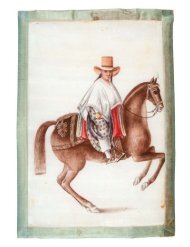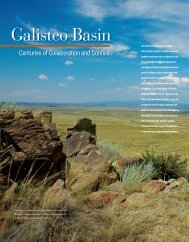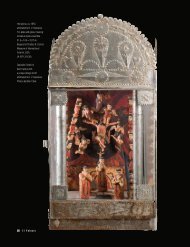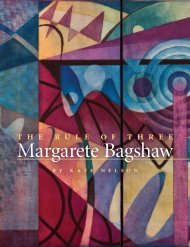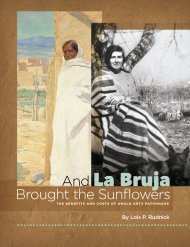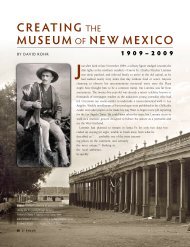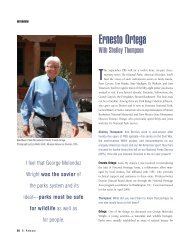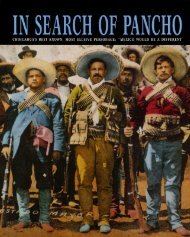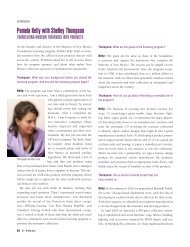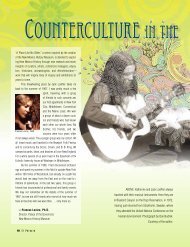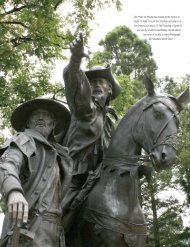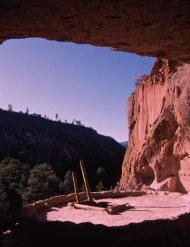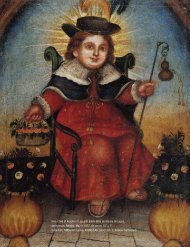Secrets of Casas Grandes - El Palacio Magazine
Secrets of Casas Grandes - El Palacio Magazine
Secrets of Casas Grandes - El Palacio Magazine
- No tags were found...
Create successful ePaper yourself
Turn your PDF publications into a flip-book with our unique Google optimized e-Paper software.
secrets <strong>of</strong> casas grandesThe Ceramic TraditionThe people <strong>of</strong> <strong>Casas</strong> <strong>Grandes</strong> left no written accounts but theirpottery has endured to tell us about their society. Potters collectedhigh-quality local white clays to form vessels by hand.The typical form is a globular jar or olla. Ceramics were usedeveryday in both domestic and ritual contexts.The striking pottery <strong>of</strong> the Medio period (a.d. 1200–1450)has bold geometric designs painted in red and black on a lightbackground. <strong>Casas</strong> <strong>Grandes</strong> potters produced a wide variety<strong>of</strong> types and forms. Ramos Polychrome is the most prevalent,and appears to have been made in the core area and exportedto other villages. Archaeologist Maria Sprehn finds that therise <strong>of</strong> pottery specialization coincided with the rise <strong>of</strong> an elitein the Medio period, as elite patrons may have commissionedspecialist artists to make the finest pieces.The symbolic importance <strong>of</strong> macaws and serpents isunmistakable, as they are among the images most frequentlydepicted on pottery. Serpents may symbolize Quetzalcóatl,Mesoamerican deity <strong>of</strong> the underworld, or they may be connectedto the Water Serpent <strong>of</strong> the Pueblos. Although the birdserpent may have been transmitted from Mesoamerica, it islikely that the underlying ideas may have been interpreted differentlyas this symbol spread throughout the Southwest.One <strong>of</strong> the secrets <strong>of</strong> <strong>Casas</strong> <strong>Grandes</strong> that continues topuzzle archaeologists is why potters madesuch a variety <strong>of</strong> ceramic effigyjars. Effigies are sculptural formsdepicting animals, humans, andother beings. They portraybirds, badgers, fish, andturtles, along with fantasticalcomposite creaturessuch as a cross betweena rabbit and a bird.“Janus” pots have thesame face on both sides,reflecting the importance<strong>of</strong> duality. Hooded effigies,with a human-like head abovea jar, have been interpreted by DiPeso as Mesoamerican deities. Oneresearcher argues that effigy vessels were setin wall niches in domestic rooms, where they may havebeen used to present food and drink <strong>of</strong>ferings.Female and male effigies may be more closely related toa Mesoamerican tradition, as human effigies are rare in theSouthwest. Information about dress and adornment are seenin details <strong>of</strong> jewelry, textiles, sashes, headbands, and facialdecoration. Females are seated with both legs extended, whilemales kneel or have one knee flexed to the chest. ArchaeologistChristine VanPool argues that smoking male effigies depictritual activity and may represent shamans, possible religiousleaders <strong>of</strong> <strong>Casas</strong> <strong>Grandes</strong>.Exotic Goods and <strong>El</strong>itesExotic artifacts at Paquimé surpass amounts found at otherSouthwestern sites. Workshop and storage rooms containedornaments <strong>of</strong> shell, copper, and turquoise. Over four millionpieces <strong>of</strong> shell were found, weighing one and a half tons. Shellwas transported from the coast and made into jewelry. Fivethousand pieces <strong>of</strong> turquoise were found, as jewelry and buriedin room corners as <strong>of</strong>ferings. Turquoise likely originatedfrom the Cerrillos mines or Burro Mountains <strong>of</strong> New Mexico.A probable trade network exported the sacred stone from theSouthwest to central Mexico.<strong>Casas</strong> <strong>Grandes</strong> society appears to have centered arounda prestige goods economy based on long-distance trade <strong>of</strong>macaws, shell, and turquoise. One <strong>of</strong> its secrets is why exoticgoods were stockpiled at the site. Somepropose Paquimé was a pilgrimage centeror that the goods represent storedwealth. Exotic goods may havebeen controlled by elites whowere religious leaders. Theassociation <strong>of</strong> elites withrare artifacts and symbols<strong>of</strong> authority reveals statusdifferences among the<strong>Casas</strong> <strong>Grandes</strong> people.The RegionalSystemWe are only beginning tounderstand the role <strong>of</strong> Paquiméwithin the larger region. The surroundingarea contains hundreds <strong>of</strong> sites, just nowbeing scientifically studied, that were all part <strong>of</strong> the <strong>Casas</strong>continued on page 88<strong>El</strong> <strong>Palacio</strong> 37



